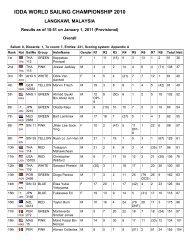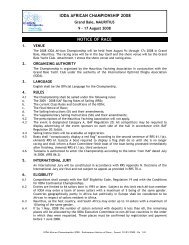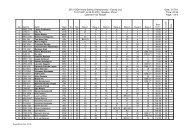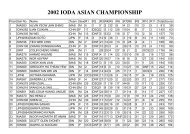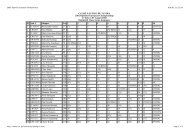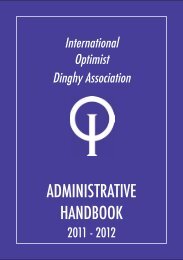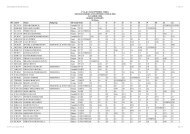2011 INTERNATIONAL OPTIMIST CLASS RULES
2011 INTERNATIONAL OPTIMIST CLASS RULES
2011 INTERNATIONAL OPTIMIST CLASS RULES
Create successful ePaper yourself
Turn your PDF publications into a flip-book with our unique Google optimized e-Paper software.
2.7.5 The sail shall carry identification marks indicated in rule 6.5 and each sail manufactured<br />
or measured after January 1st 1990 shall have permanently fixed near its tack an officially<br />
numbered sail button. No sail shall be accepted for its first measurement without a<br />
sail button. Buttons shall not be transferred from one sail to another. Buttons shall normally<br />
be obtained from the International Optimist Dinghy Association (IODA) by the sailmakers<br />
but may also be obtained, if necessary, by National Class Associations.<br />
2.7.6 All emblems, plaques, marks and numbers shall be clearly legible, of durable material<br />
and shall be securely attached.<br />
2.8 Advertising<br />
The Optimist Class is Category A.<br />
As approved by the International Sailing Federation (ISAF), any National Owners<br />
Association with the consent of its Member National Authority (MNA) may permit full or<br />
restricted Category C for boats of that nation sailing in their national waters.<br />
Such advertising may relate to the ownership of the boat (i.e. may be restricted to club<br />
owned boats etc. only)<br />
3 CONSTRUCTION AND MEASUREMENT <strong>RULES</strong><br />
3.1 General<br />
3.1.1 All boats shall be built according to the Class Rules (see also CR 2.1.3). The dimensions<br />
and shape of the hull shall be as shown on the plans and as given in these rules, diagrams<br />
and measurement forms and shall conform with the tolerances stated therein.<br />
Materials shall be as specified in these Class Rules except that titanium, carbon fibre or<br />
other exotic materials are prohibited.<br />
3.1.2 Any attempt to concentrate the weight of the hull is prohibited.<br />
3.2 Hull<br />
3.2.1 Materials - GRP.<br />
For CR 3.2.1 for wood and wood/epoxy hulls, see Appendix A.<br />
3.2.1.1 The hull shall be constructed of materials approved by the ISAF. The following are the<br />
currently approved materials: Glass Reinforced Plastic (GRP).<br />
3.2.1.2 Hulls shall be constructed from:<br />
Mat 300 ( +/- 10% ) Mat 450 (+/- 10%)<br />
Woven Cloth or Biaxial 280 (+/-10%)<br />
Resin<br />
Bonding agent<br />
Gel coat<br />
Paint<br />
Foam core 13/60 ( +/-10% )<br />
Chopped strand mat of E glass fibres<br />
Cloth of woven or otherwise biaxial applied skeins of<br />
continuous E glass fibres<br />
Polyester resin for GRP lamination.<br />
Of any material to bond hull components and backing<br />
plates where appropriate.<br />
May be of any colour<br />
May be of any colour<br />
Durable, non-absorbent closed cell PVC foam which shall be<br />
bonded to the walls (see also CR 3.2.3.2)<br />
Mats & woven cloth are specified in grams per square metre +/- 10% (gr./m 2 )<br />
The E glass fibres and Polyester resin shall be transparent. Coloured fibres and resins<br />
are prohibited.<br />
6



